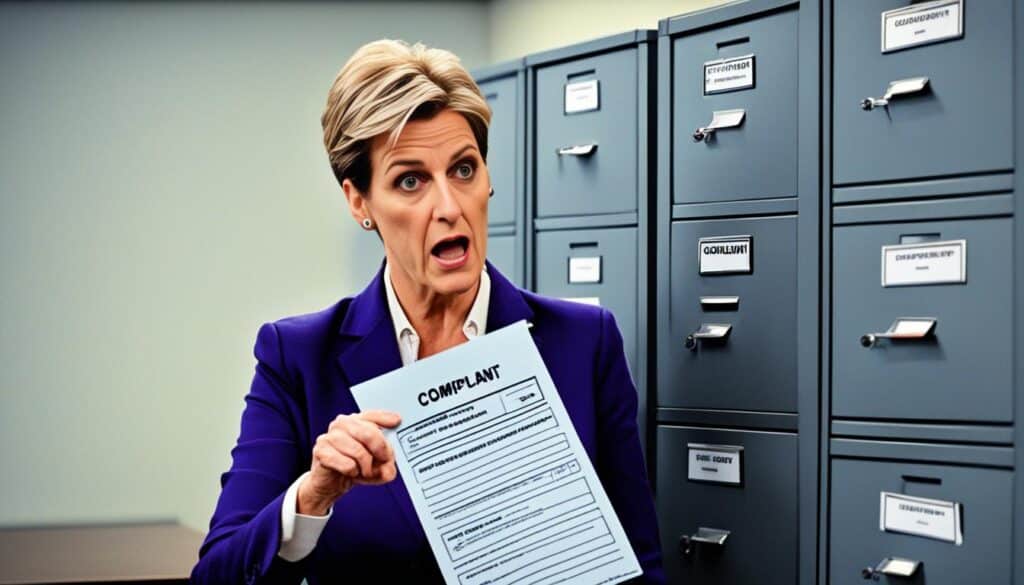
When your consumer rights are breached, it’s important to know the steps to take in order to protect yourself and seek justice. By following a step-by-step approach, you can navigate the legal process and ensure that your rights are upheld. Here, I will outline the essential steps you should take when your consumer rights are violated.
Key Takeaways:
- Steps to take when your consumer rights are violated:
- Gather evidence of the violation.
- Review the terms and conditions.
- Contact the seller or service provider.
- File a complaint with the relevant authorities.
- Consider alternative dispute resolution methods.
- Consult with an attorney.
By following these steps, you can assert your rights as a consumer and seek a resolution to the violation. It’s important to take action and protect yourself when your consumer rights are infringed upon.
Gather Evidence of the Violation
When your consumer rights are violated, gathering evidence is crucial to support your case and strengthen your position when seeking resolution. By collecting the necessary documentation, you can clearly demonstrate the violation in question and protect your consumer rights.
Here are some steps you can take to gather evidence of the violation:
- Keep records: Maintain a detailed record of all communications, including emails, text messages, and phone calls, between you and the other party involved in the transaction or agreement.
- Save receipts: Keep copies of receipts, invoices, or any other documents related to the transaction. These can serve as evidence of the terms and conditions agreed upon.
- Document conversations: If you have conversations with the seller or service provider regarding the violation, make sure to take notes and record the date, time, and content of the conversation.
- Take photographs: If applicable, take clear photographs that visually capture any physical evidence of the violation, such as defective products or substandard services.
Remember, the more evidence you gather, the stronger your case will be. Documentation and clear records are essential to proving your claims and protecting your consumer rights.
Gathered Evidence Case Study
To illustrate the importance of gathering evidence, let’s consider a case study:
| Evidence | Impact |
|---|---|
| Recordings of phone calls | Provides proof of the seller’s misleading statements and commitment to fulfilling certain obligations. |
| Email exchanges with timestamps | Verifies the attempts made by the consumer to resolve the issue and highlights the lack of response from the seller. |
| Copies of receipts | Clearly shows the terms and conditions agreed upon, including warranties and guarantees. |
| Photographs of damaged product | Visual evidence of the quality discrepancy between what was advertised and what was received. |
In this case, the gathered evidence strengthens the consumer’s position, providing substantial proof of the violation and supporting the claim for a resolution in their favor.
Review the Terms and Conditions
Once you have gathered evidence of the violation, the next step is to carefully review the terms and conditions of the agreement or contract that was breached. It is essential to familiarize yourself with the specific consumer rights that were violated and identify any clauses or provisions that support your position. This thorough examination of the terms and conditions will help you understand your rights and provide a solid basis for your claim.
By reviewing the terms and conditions, you can identify any unfair or deceptive practices that may have occurred. Look for any discrepancies between what was promised and what was delivered, as well as any hidden fees or restrictive clauses that may have violated your consumer rights. Take note of any language that may be ambiguous or misleading, as this can be used to strengthen your case.
It is important to remember that terms and conditions are a legally binding agreement between you and the seller or service provider. Understanding these terms is crucial to asserting your rights and seeking a resolution for the violation.
During your review, make sure to take note of any specific deadlines or procedures outlined in the terms and conditions. Failure to adhere to these requirements may impact your ability to seek recourse and may be used against you by the other party.
Additionally, if you come across any illegal or unconscionable terms in the agreement, it is advisable to consult with an attorney to fully understand the ramifications and legal options available to you.
Example:
Here is an example of a table summarizing important clauses in the terms and conditions of a fictitious online marketplace:
| Clause | Description |
|---|---|
| Refund Policy | Customers are entitled to a full refund within 30 days of purchase if the product is defective or not as described. |
| Shipping and Delivery | The seller is responsible for shipping the product within 3 business days of receiving the order. Delivery timeframes may vary depending on the location of the customer. |
| Dispute Resolution | Any disputes arising from the transaction will be resolved through binding arbitration. |
| Termination of Account | The marketplace reserves the right to terminate user accounts for violation of the terms and conditions, including fraudulent or deceptive behavior. |
This table provides a clear summary of the clauses that are relevant to consumer rights and can serve as a reference when reviewing the terms and conditions of your own agreement.
Contact the Seller or Service Provider
Once you have gathered evidence and reviewed the terms and conditions, it’s time to contact the seller or service provider. It is important to establish communication with them to address the violation of your consumer rights. Reach out to them through written correspondence, such as a formal complaint letter, or by phone. Be sure to clearly explain the nature of the violation and provide them with the supporting evidence you have collected. This will help them understand the severity of the situation and the impact it has had on your rights and interests.
I recommend using a polite and professional tone during your communication. Clearly state your expectations for resolution and give them a reasonable timeframe to respond. By providing them with this information, you are giving them the opportunity to rectify the situation and demonstrate their commitment to consumer satisfaction. Keep records of your communication with the seller or service provider, including dates, times, and individuals involved, for future reference and documentation.
Sample Letter
If you choose to write a formal complaint letter, below is a template you can use as a starting point:
[Your Name]
[Your Address]
[City, State, ZIP Code]
[Email Address]
[Phone Number]
[Date][Seller’s or Service Provider’s Name]
[Their Address]
[City, State, ZIP Code]Subject: Formal Complaint Regarding Violation of Consumer Rights
Dear [Seller’s or Service Provider’s Name],
I am writing to bring to your attention the violation of my consumer rights that has occurred in relation to our recent transaction/agreement. Despite my initial expectations and the terms outlined in our agreement, I have experienced significant issues that warrant immediate attention and resolution.
Attached to this letter, you will find the evidence I have gathered, including [state the types of evidence]. These documents clearly highlight the breach of my consumer rights and the negative impact it has had on my experience as a customer.
I kindly request that you take this matter seriously and take the necessary steps to address the violation of my consumer rights. I expect a prompt and satisfactory resolution to the issue within [reasonable timeframe, e.g., 14 days] of receiving this letter. Failure to do so may result in further action being taken, including filing a formal complaint with the relevant authorities.
I trust that you value your customers and their satisfaction. As such, I anticipate that you will address this issue responsibly and demonstrate your commitment to upholding consumer rights.
Should you require any further information or clarification, please do not hesitate to contact me at [phone number] or via email at [email address]. I look forward to receiving a timely response and resolving this matter amicably.
Yours sincerely,
[Your Name]
Remember to tailor this template to your specific situation and personalize it according to your experience. Be sure to keep a copy of the letter for your records.
Next Steps
After contacting the seller or service provider, it is important to keep a record of your communication and any responses you receive. If they respond and offer a resolution, evaluate their proposal and assess whether it adequately addresses the violation of your consumer rights. If their response is unsatisfactory or you do not receive a response within the given timeframe, you may need to proceed to the next steps, which involve filing a formal complaint with the relevant authorities.
Continue to Section 5 to learn more about how to file a complaint and escalate the matter if necessary.
File a Complaint with the Relevant Authorities
If the seller or service provider does not respond or fails to resolve the issue satisfactorily, I may need to escalate my complaint by filing a formal complaint with the relevant authorities. This could include government agencies, consumer protection organizations, or industry-specific regulatory bodies. I will provide them with all the necessary details and evidence to support my claim, ensuring that my consumer rights are protected and upheld.
Consider Alternative Dispute Resolution Methods
In some cases, when your consumer rights are violated, it may be beneficial to explore alternative dispute resolution methods as an alternative to pursuing legal action. Alternative dispute resolution methods offer a quicker and more cost-effective way to resolve the issue while still protecting your rights as a consumer.
One such option is mediation, where a neutral third-party mediator facilitates a discussion between you and the opposing party. This allows for open communication and helps find a mutually agreeable resolution. Mediation can be particularly useful when the relationship with the seller or service provider is important to you, such as in ongoing business partnerships or professional services.
Another alternative is arbitration, which involves presenting your case before an impartial arbitrator or panel. The arbitrator reviews the evidence and makes a binding decision that both parties must abide by. Arbitration can be less formal and time-consuming than litigation, making it a viable option for resolving consumer disputes.
It’s essential to research and understand the available alternative dispute resolution options to determine if they are suitable for your specific situation. Consider the advantages and disadvantages of each method and weigh them against the potential outcomes of pursuing legal action. Consulting with an attorney who specializes in consumer rights can provide valuable guidance in assessing the most appropriate course of action.
Alternative dispute resolution methods such as mediation and arbitration offer a streamlined and less adversarial approach to resolving consumer disputes. By considering these options, you can seek a resolution that saves time, money, and preserves the relationship with the seller or service provider.
Consult with an Attorney
If all attempts at resolution have failed, it may be necessary to consult with an attorney who specializes in consumer rights. They can provide you with legal advice, assess the strength of your case, and guide you through the legal process. An attorney will ensure that your rights are protected and help you navigate the complexities of the legal system.
Conclusion
In conclusion, when your consumer rights are breached, it is essential to take the appropriate steps to protect yourself and seek justice. By following a well-defined process, you can navigate the legal landscape and ensure that your rights are upheld.
The first step is to gather evidence of the violation. Keep records of all relevant communication, receipts, and documentation to support your case. This evidence will be crucial in strengthening your position when seeking resolution.
Next, carefully review the terms and conditions of the agreement or contract that was breached. Identify the specific consumer rights that were violated and any clauses or provisions that support your claim. Understanding your rights and having a solid basis for your case is essential.
Contact the seller or service provider and explain the violation of your consumer rights. Provide them with the evidence you have gathered and clearly communicate your expectations for resolution. If they fail to respond or resolve the issue, you may need to file a formal complaint with the relevant authorities.
Consider alternative dispute resolution methods before pursuing legal action. Mediation or arbitration can provide a quicker and more cost-effective way to resolve the issue. Research your options and determine if they are suitable for your specific situation.
If all else fails, consult with an attorney who specializes in consumer rights. They can provide you with legal advice, assess the strength of your case, and guide you through the legal process. An attorney will ensure that your rights are protected as you seek justice.
Remember, embracing your consumer rights is crucial. By taking these steps, you can seek the justice you deserve and ensure that your rights are respected and honored.
FAQ
What should I do if my consumer rights are violated?
When your consumer rights are violated, it is important to take certain steps to protect yourself and seek justice. Follow this step-by-step approach to address the violation effectively.
How can I gather evidence of the violation?
To gather evidence of the violation, keep records of any communications, receipts, or documentation related to the transaction or agreement. These will support your case and strengthen your position when seeking resolution.
Why is it important to review the terms and conditions?
Reviewing the terms and conditions of the agreement or contract that was breached is important to familiarize yourself with the specific consumer rights that were violated. It will also help you identify any clauses or provisions that support your position.
How should I contact the seller or service provider?
When contacting the seller or service provider, explain the violation of your consumer rights and provide them with the supporting evidence. This can be done through written correspondence, such as a formal complaint letter, or by phone. Clearly communicate your expectations for resolution and give them a reasonable timeframe to respond.
What should I do if the seller or service provider does not respond or resolve the issue?
If the seller or service provider does not respond or fails to resolve the issue satisfactorily, you may need to escalate your complaint by filing a formal complaint with the relevant authorities. This could include government agencies, consumer protection organizations, or industry-specific regulatory bodies. Provide them with all the necessary details and evidence to support your claim.
Should I consider alternative dispute resolution methods?
In some cases, it may be beneficial to consider alternative dispute resolution methods before pursuing legal action. This includes options such as mediation or arbitration, which can provide a quicker and more cost-effective way to resolve the issue. Research the available options and determine if they are suitable for your specific situation.
When should I consult with an attorney?
If all attempts at resolution have failed, it may be necessary to consult with an attorney who specializes in consumer rights. They can provide you with legal advice, assess the strength of your case, and guide you through the legal process. An attorney will ensure that your rights are protected and help you navigate the complexities of the legal system.
Source Links
- https://www.sandiegouniontribune.com/business/nation/story/2024-01-30/europes-economic-blahs-drag-on-with-zero-growth-at-the-end-of-last-year
- https://www.nbc4i.com/news/national/universal-shares-first-look-at-epic-universe-theme-park-portals-to-immersive-worlds/
- https://www.washingtonpost.com/opinions/2024/01/30/dc-crime-bill-backward/










